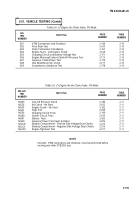TM-9-2320-361-20 - Page 238 of 1207
2-20. STE/lCE DESCRIPTION AND OPERATION (Contd)
Table 2-5. Status Readouts.
TM 9-2320-361-20
VTM Readout
Interpretation
.8.8.8.8
A readout of .8.8.8.8 appears for 1 to 2 seconds each time power is applied to VTM.
It means that there is power to the VTM, and all elements of readout display are
operative.
A readout of four dashes indicates the following
(1) After power is turned on, it signifies that VTM is ready for testing.
(2) During a compression unbalance test, it signifies testing is in progress.
(3) During battery condition test, it signifies battery may be in discharged state.
.9.9.9.9
A readout of .9.9.9.9 indicates that VTM is reading a test value beyond the range of
its measurement capability. Either (1) the wrong test number is selected for
parameter being measured; (2) there is fault in vehicle; or (3) during battery
condition test, it signifies bad connections, discharged, or bad batteries.
PASS
PASS or FAIL readout is the result of a test that checks the condition of a com-
FAIL
ponent being measured. A PASS/FAIL readout means component either passes the
test or fails the test.
Table 2-6. Prompting Messages.
VTM Readout
Interpretation
UEH
Signal to technician to enter vehicle identification number (VID) on TEST SELECT
switches. Vehicle ID numbers are found under TEST DATA on flip cards, on vehicle
test card, and in appendix.
GO
Signal to technician to crank engine in compression balance or first peak tests.
During battery condition test, indicates a weak battery in series pair of batteries
being tested.
CIP
Signal to technician to apply full throttle in a C1 power test.
OFF
Signal to technician to stop cranking in compression balance test.
CAL
Signal to technician to release the TEST button during an offset test.
66
Numbers are used for prompting messages in several tests. They are as follows:
in confidence, test 66 signals the technician to dial in"99", in CI acceleration/deceleration
power test No. 12, the first numerical readout signals the technician to shut off fuel.
2-153
Back to Top




















